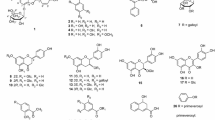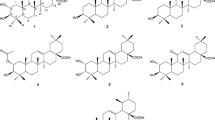Abstract
The effects of 80% methanol extracts from frozen samples of 41 macroalgae and one sea grass collected in the Ise-Shima region of Japan were investigated on histamine release from rat basophile leukemia cells (RBL-2H3) sensitized with antidinitrophenyl (DNP) IgE and stimulated with DNP-BSA. Of the 21 brown algae, five green and 15 red algae, and one sea grass tested, only extracts from seven brown algae suppressed histamine release from RBL cells, as determined by highperformance liquid chromatography (HPLC) analysis. When the cytotoxic effects of the seven brown algal extracts were investigated by Trypan blue staining, only Eisenia arborea and Sargassum thunbergil did not show cytotoxic effects. Therefore, we conclude that E. arborea and S. thunbergii may contain compounds that have antiallergic effects without inducing cell death.
Similar content being viewed by others
References
Matsuo N, Yamada K, Shoji K, Mori M, Sugano M. Effects of tea polyphenols on histamine release from rat basophilic leukemia (RBL-2H3) cells: the structure-inhibitory activity relationship. Allergy 1997; 52: 58–64.
Suzuki M, Yoshino K, Maeda-Yamamoto M, Miyase T, Sano M. Inhibitory effects of tea catechins and O-methylated derivatives of (−)-Epigallocatechin-3-O-gallate on mouse type IV allergy. J. Agric. Food Chem. 2000; 48: 5649–5653.
Ueda H, Yamazaki M. Inhibition of tumor necrosis factor-α production by orally administering a Perilla leaf extract. Biosci. Biotechn Biochem. 1997; 61: 1292–1295.
Ishikura Y, Suwa Y, Okada T, Kono S. Anti-allergic effects of Rubus suavissimus extract. Jpn. J. Inflamm 1995; 15: 167–173 (in Japanese).
Sudo N, Yu XN, Aiba Y, Oyama N, Sonoda J, Koga Y, Kubo C. An oral introduction of intestinal bacteria prevents the development of a long-term Th2-skewed immunological memory induced by neonatal antibiotic treatment in mice. Clin. Exp. Allergy 2002; 32: 1112–1116.
Ishida Y, Bandou I, Kanzato H, Yamamoto N. Decrease in ovalbumin specific IgE mice serum after oral uptake of lactic acid bacteria. Biosci. Biotechn Biochem. 2003; 67: 951–957.
Nagura T, Hachimura S, Hashiguchi M, Ueda Y, Kanno T, Kikuchi H, Sayama K, Kaminogawa S. Suppressive effect of dietary raffinose on T-helper 2 cell-mediated immunity. Br. J. Nutr. 2002; 88: 421–426.
Terao K, Tachi I, Nakata D inventors; Cyclochem Co., Ltd assignee. A clinical drug or food to inhibit a production of IgE antibody. Japan Kokai Tokkyo Koho. P2006-8568A 2006; 12 January (in Japanese).
Kawasaki M, Toyoda M, Teshima R, Sawada J, Saito Y. Effect of α-linolenic acid on the metabolism of-3 and-6 polyunsaturated fatty acids and histamine release in RBL-2H3 cells. Biol. Pharm. Bull. 1994; 17: 1321–1325.
Maruyama H, Tamauchi H, Hashimoto M, Nakano T. Suppression of Th2 immune responses by Mekabu fucoidan from Undaria pinnatifida sporophyllus. Int. Arch. Allergy Immunol. 2005; 137: 289–294.
Asada M, Sugiue M, Inoue M, Nakagomi K, Hongo S, Murata K, Irie S, Takeuchi T, Tomizuka N, Oka S. Inhibitory effect of alginic acids on hyaluronidase and on histamine release from mast cells. Biosci. Biotechn Biochem. 1997; 61: 1030–1032.
Katsube T, Yamasaki Y, Iwamoto M, Oka S. Hyaluronidase-inhibiting polysaccharide isolated and purified from hot water extract of sporophyll of Undaria pinnatifida. Food Sci. Technol. Res. 2003; 9: 25–29.
Shibata T, Fujimoto K, Nagayama K, Yamaguchi K, Nakamura T. Inhibitory activity of brown algal phlorotannins against hyaluronidase. Int. J. Food Sci. Technol. 2002; 37: 703–709.
Shibata T, Nagayama K, Tanaka R, Yamaguchi K, Nakamura T. Inhibitory effects of brown algal phlorotannins on phospholipase A2s, lipoxygenases and cyclooxygenases. J. Appl. Phycol. 2003; 15: 61–66.
Ishihara K, Murata M, Kaneniwa M, Saito H, Shinohara K, Maeda-Yamamoto M. Inhibition of icosanoid production in MC/9 mouse mast cells by n-3 polyunsaturated fatty acids isolated from edible marine algae. Biosci. Biotechnol. Biochem. 1998; 62: 1412–1415.
Ishihara K, Murata M, Kaneniwa M, Saito H, Shinohara K, Maeda-Yamamoto M, Kawasaki K, Ooizumi T. Effect of tetracosahexanoic acid on the content and release of histamine, and eicosanoid production in MC/9 mouse mast cell. Lipids 1998; 33: 1107–1114.
Na HJ, Moon PD, Ko SG, Lee HJ, Jung HA, Hong SH, Seo Y, Oh JM, Lee BH, Choi BW, Kim HM. Sargassum hemiphyllum inhibits atopic allergic reaction via the regulation of inflammatory mediators. J. Pharmacol. Sci. 2005; 97: 219–226.
Bursumian EL, Isersky C, Petorino MG, Siraganian RP. IgE-induced histamine release from rat basophilic leukemia cell lines: isolation of releasing and nonreleasing clones. Eur. J. Immunol. 1981; 11: 317–323.
Saito K, Horie M, Nose N. High-performance liquid chromatography of histamine and I-methylhistamine with oncolumn fluorescence derivatization. J. Chromatogr. 1992; 595: 163–168.
Kaekgawa H, Matsumoto H, Endo K, Satoh T, Nonaka G, Nishioka I. Inhibitory effects of tannins on hyaluronidase activation and on the degranulation from rat mesentery mast cells. Chem. Pharm. Bull. 1985; 33: 5079–5082.
Tachibana H, Sunada Y, Miyase T, Sano M, Maeda-Yamamoto M, Yamada K. Identification of a methylated tea catechin as an inhibitor of degranulation in human basophilic KU812 cells. Biosci. Biotechnol. Biochem. 2000; 64: 452–454.
Nakamura T, Nagayama K, Uchida T, Tanaka R. Antioxidant activity of phlorotannins isolated from brown alga Eisenia bicyclis. Fish. Sci. 1996; 62: 923–926.
Nakamura H, Yamaguchi S, Hayashi T, Baba M, Okada Y, Tanaka J, Tokuda H, Nishino H, Okuyama T. Studies on the biological activities of marine algae (III) Anti-tumor promoting activity and inhibitory effect on aldose reductase. Nat. Med. 1997; 51: 162–169 (in Japanese).
Kobayashi A, Hashimoto M, Nakano T, Tamura S, Hidano N inventors; Nagase & Co., Ltd. and Riken Vitamin Co., Ltd assignees. A clinical drug or food to inhibit a production of IgE antibody. Japan Kokai Tokkyo Koho, P2001-31585A. 2001; 6 February (in Japanese).
Iwahori Y, Enomoto S, Okada Y, Tanaka J, Okuyama T. Naturally occurring substances of prevention of complications of diabetes (IV) Screening of sea vegetables for inhibitory effect on aldose reductase. Nat. Med. 1999; 53: 138–140.
Okada Y, Ishimaru A, Suzuki R, Okuyama T. A new phloroglucinol derivatives from the brown alga Eisenia bicyclis. Potential for the effective treatment of diabetic complications. J. Nat. Prod 2004; 67: 103–105.
Fukuyama Y, Miura I, Kinzyo Z, Mori H, Kido M, Nakayama Y, Takahashi M, Ochi M, Eckols, novel phlorotannins with a dibenzo-p-dioxin skeleton possessing inhibitory effects on 2-macroglobulin from the brown alga Ecklonia kurome Okamura. Chem. Lett. 1985; 14: 739–742.
Ahn MJ, Yoon KD, Kim CY, Min SY, Kim Y, Kim HJ, Huh H, Kim J. Inhibition of HIV-1 reverse transcriptase and HIV-1 integrase and antiviral activity of Korean seaweed extracts. J. Appl. Phycol. 2002; 14: 325–329.
Nagayama K, Iwamura Y, Shibata, T, Hirayama I, Nakamura T. Bactericidal activity of phlorotannins from the brown alga Ecklonia kurome. J. Antimicrob. Chemother. 2002; 50: 889–893.
Myung CS, Shin HC, Bao HY, Yeo SJ, Lee BH, Kang JS. Improvement of memory by dieckol and phlorofucofuroeckol in ethanol-treated mice: possible involvement of the inhibition of acetylcholineesterase. Arch. Pharm. Res. 2005; 28: 691–698.
Kita N, Fujimoto K, Nakajima I, Hayashi R, Shibuya K. Screening test for deodorizing substances from marine algae and identification of phlorotannins as the effective ingredients in Eisenia bicyclis. J. Appl. Phycol. 1990; 2: 155–162.
Author information
Authors and Affiliations
Corresponding author
Rights and permissions
About this article
Cite this article
Sugiura, Y., Takeuchi, Y., Kakinuma, M. et al. Inhibitory effects of seaweeds on histamine release from rat basophile leukemia cells (RBL-2H3). Fish Sci 72, 1286–1291 (2006). https://doi.org/10.1111/j.1444-2906.2006.01287.x
Received:
Accepted:
Issue Date:
DOI: https://doi.org/10.1111/j.1444-2906.2006.01287.x




